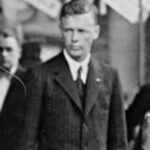The beginning of aviation began in 1903 with the Wright brothers’ first successful flight in Kitty Hawk. During this time period of the early 1900’s, many people did not see airplane travel as an option due to the lack of safety appeal. World War I assisted in the initial development of the industry; however the government halted research and development funds causing a rapid decline in growth. Finally, in 1927, there was a breakthrough of overall interest in flying as Charles Lindbergh completed his journey across the Atlantic Ocean.
The United States Postal Service also became one of the biggest factors in the growth of the air transportation industry during this time. The 1925 Kelly Airmail Act allowed private airlines the ability to become mail carriers. In using the airmail profits, many of the private companies expanded and eventually included passengers. Federal regulation began in 1926 when the Air Commerce Act was passed to assist in passenger safety.
World War II helped generate support for research and development of airplanes, eventually leading to assistance with commercial aviation. This assistance lead to the innovation of a four-engine aircraft that cut flying times tremendously. Planes were modernized, and jet service was introduced in 1959, enabling even faster cross-country service.
The Federal Aviation Administration (FAA) was created after the Federal Aviation Act was passed in 1958 due to a major increase of in-air collisions that were taking place. The 1970s saw dramatic increases in costs, particularly increases in fuel prices. The 1980s were marked by the deregulation of the industry, which resulted in the growth of smaller carriers and the mergers of larger carriers. The 1990s saw a dramatic increase in the number of passengers, including first time passengers, as prices were cut and the cities served by airlines increased.
Cost Efficiency
Cost efficiency has become a significant matter in the ability for companies to compete and survive in the airline industry. Many companies within the industry consider themselves low cost operators, but it does not take this type of management approach as long as the service is of quality and provided in an efficient manner. The ability to use resources to the fullest capacity at the least cost available is highly important in this concept.
The growth of the “no frills, low cost” airline companies has changed competition within the air industry. The major airline companies have attempted different methods of operation and fewer service offerings in order to lower their cost and consumer air fare. Strong competition within the market has forced the airlines to respond or quickly fail. Without the ability to respond by improving cost efficiency’s, companies tend to fail mostly due to the rise in jet fuel costs within the past few years. “Major restructuring among US airlines has seen a reduction in their unit costs by over 10% between
2001 and 2004, with an even greater 17% reduction in non-fuel operating costs over the same period.” (Smyth & Pearce, 2006) Again, the ultimate goal is to deliver services economically and efficiently to a specific target base willing to pay for quality service. Making these cost efficient adjustments can become a complicated and highly involved process.
“The reasons for the imperiled condition of the industry are clear. The industry has always struggled with high costs. Stubbornly high fuel prices, escalating insurance costs and spiraling labor expenses, among other things, have combined with a particular vengeance in an underperforming economy exacerbated by the aftermath of 9/11.” (May, 2003) As costs in the industry increase, less flights will be available and higher prices will become apparent. The airline industry is a very costly business to manage and in order to remain active these companies need to maximize their profit effectively. This has been and continues to be a remaining struggle for many of the airlines in the business. Although airlines are still a demand in the struggling economy, the demand for services is much less than it used to be. Therefore, supply will continue to decrease and the price to the consumers will increase. The consumers that demand the services will find alternatives as these price increases.
Economics
Several major impacts on the airline industry have severely crippled the ability for airlines to turn an economic profit. These include the terrorist attacks of September 11, 2001, rising fuel prices, cost of replacing aging aircraft, and rising wages among the airline labor force. These are all factors facing the airline industry today and account for the vast amount of red ink on many airlines’ balance sheets.
September 11, 2001 will always be considered a turning point in the history of America. Terrorist attacks in New York City and Washington D.C. proved to be a major catastrophe for the airline industry. The airspace in the United States completely closed for the first time ever for four days. Immediately following the attacks demand for the airline industry declined and airline companies began losing financial positions along with their number of flights. It has since been six years and the airline industry is just beginning to emerge from the tragedies of that day. Due to the shut down of United States airspace the industry saw losses exceeding $330 million per day. Within the first week after the closed skyway the industry reported losses between $1 and $2 billion. Costs incurred from the creation of the Transportation Security Administration, baggage screeners, and ticket fees are making Americans look for substitutes such as driving, teleconferencing, and web casting which contribute in hindering the recovery of demand for the industry. Due to the decrease in demand, the price of airfares has dropped in order to regain demand. However, the decrease in demand coupled with the decline in price has greatly reduced the industries revenues. This demonstration of decreasing demand in the airline industry has lost its pricing power.
Rising fuel costs are among concerns to the airline industry too. Fuel is the second largest operating expense for airlines. For every one cent increase in the cost of a gallon of jet fuel the industry will suffer a cost of $180 million per year. “Again put in terms of costs per day basing off of 2005 usage every dollar increase in the price of a barrel of jet fuel adds nearly $1.3 million in daily industry operating expenses” (Heimlich, 2006). Some airlines such as Southwest have been able to lock in fuel prices and therefore control costs in an effort to be the leader of the short haul, low fare, high frequency, point to point niche in the market. But these fuel contracts are for a limited time. Many airlines are now forced to look at what they can do in the future to keep costs low as their fuel contracts are about to expire. One solution has been new winglets that decrease the drag coefficient across the wings of the jumbo jets and increase the fuel mileage. Another has been extremely quick turnaround time for departures / arrivals. The jumbo jets consume the most fuel during take off, landing and sitting idle at hubs. Some experts believe fuel prices could easily be seen at over $100 a barrel in the very near future, while in 2005 the airline industry enjoyed a relaxed price $50.72 per barrel, (Heimlich, 2006).
Among the airline industry the labor force makes up the largest segment of operating expenses. Some 40% of expenses are used to pay pilots, flight attendants, baggage handlers, dispatchers, and customer service representatives. Some airlines have resorted to decreasing the amount of planes in service by putting them in storage in the desert. When reducing the number of aircraft in the fleet, cuts must also come from reducing the number of personnel operating the remainder of the fleet. Some companies have actually negotiated for lower wages amongst its remaining employees in an effort to further trim costs and raise revenues.
When reviewing the economics that have faced the airline industry over the past several years we see an overwhelming amount of evidence that the events that took place on September 11, 2001 have had a major impact on the airline industry. Demand decreased immediately resulting in a decrease in airfares although not enough people were traveling for many airlines to earn a profit. New costs incurred from security changes and delays are incurred directly on the industry as well as rising fuel prices. Airlines are continually searching for ways to reduce their costs in an effort to be more profitable.
Weaknesses – Threats – Government
The airline industry has been struggling for the past 5 years. The increase of credit card fraud, the safety issues, along with the government intervention all factor into the struggling industry. The main and contributing factor is the costs of fuel, insurance, and labor expenses. These costs have driven the cost of flying up. As the cost of flying has increased the demand of the industry has decreased dramatically.
The airline industry has struggled greatly with fraud; this issue is a huge weakness for the industry as a whole. “The average airline experienced 446 cases of fraud in 2006, with external fraud accounting for 413 of them. Although these included counterfeit or stole tickets; cargo theft, false baggage claims, frequent flyer abuse and bouncing checks, the main culprits were tariff abuse, cross-border ticketing, technology and web-based transactions, and credit card fraud.” (Deloitte, 2007) “More than a third of airlines have detected credit card fraud, which adds up to around 60% of all external fraud-related losses.” (Deloitt, 2007) Although this is not just a problem in the airlines it is a serious weakness that affects the whole industry. As more and more business is done online the more credit card fraud will be a weakness to the industry. According to Deloitte, “Far more business is conducted online today than was the case six years ago, particularly in the low cost market where airlines make it financially beneficial for passenger to book online. However, along with the rewards comes the increased risk.” Although fraud is one major weakness of the industry, many of the leading companies are struggling to prevent high costs. “Delta reported a net loss of approximately $5.2 billion: $773 million; and $1.3 billion for years ended December 2004, 2003, and 2002, respectively.” (Datamonitor Delta Airlines 7) This is just one of many who have struggled with cost in recent times. There have been many airline companies restructuring, filing bankruptcy, and raising their rates to remain in the industry. .
One major threat to the airline industry is the safety of the passengers. After the 9/11 terrorist attacks, this has been a main concern for many travelers. Safety is not just concerning terrorism, yet the overall safety for all flight operations is the main concern. Two tragic crashes, ValuJet 592’s plunge into the Florida Everglades and TWA Flight 800’s fiery fall into the Atlantic Ocean, have made Americans edgy. The flying public has long counted on the Federal Aviation Administration to make the skies safe. In the aftermath of these accidents, however, even officials like former Transportation Department Inspector General Mary Schiavo have criticized the FAA’s safety oversight” (Kettl, 1996). With the safety being a great concern for passengers many travelers will choose an alternative to flying. After the 9/11 attacks and the publicity of the recent airline crashes, many travelers choose bus, train, or car to travel instead of using the airlines.
“There is interdependency between governments and airlines such that governments use airlines sometimes to execute foreign policy situations and airlines use the government to achieve profit maximization. Additionally airlines sometimes join forces against an offending government (for its policy) or even against their own government.” (Hadzisavidis, 2006). Although government is responsible for increasing profits, it is could also be effecting it negatively. After the terrorist attacks of 9/11 government had to make safety regulations that would steer customers away from the airline industry. Even though these changes were made to protect the customers it still steered many from the industry. As time passes more customers are more likely to reconsider flying again but now there are more obstacles in the industry with the rising prices of fuel.
Competitive Structure
International competition and economies of scale within the airline industry is created through globalization, but the large market and lower costs is what creates an oligopoly market structure. This market structure gives the airlines power to set and change prices while producing similar services at different levels of output and compete with other firms within the industry. New entrants into the market makes already established airlines vulnerable. Competitors typically lower prices impacting the larger carriers because lowering prices for them still leaves them facing higher costs. “Oligopolies tend to require a high capital investment for their capacity which then becomes high fixed costs. About two-thirds of the cost structure of the airline industry is fixed costs.” (Hadzisavidis, 2006).
Summary
“As the airline industry continues to face turbulent times, travelers can anticipate higher fares, longer lines, greater delays and scaled-back service.” (Patiky, 2007) Along with economic disturbances, such as 9/11, competition within the airline industry has caused dramatic need for overall change. Cost efficiency and the ability for airlines to use resources to the fullest has become the most important concept in survival. The increase in fuel and labor cost has raised concern for airlines within the industry and caused many to lower the number of planes flown to help budget costs. The costs of flights are now rising and services offered are being decreased in order to cut cost. Individuals, businesses and entrepreneurs are also buying solo or partnering to buy private planes to save time and money.
It has become more practical and affordable for businesses and individuals to have personal aircraft. In fact, about 23,000 aircrafts are privately operated and have access to more than 5,000 U.S. communities. The time and money saved can tremendously effect a companies operation and maximization of its resources. Independent research shows that the uninterrupted time onboard your jet is actually more productive than time spent in an office.” (Patiky, 2007) These aircraft carriers are now made with satellite communications and the ability to connect laptops, printers, and much more. These economically convenient measures are most reliable in both time and financial management.
References
Deloitte & Touche LLC. (2007). Fraud in the Airline Industry. Retrieved April 27, from http://www.deloitte.com/dtt/cda/doc/content/UK_THL_FraudintheAirlineIndustry_Apr07.pdf
Energy Challenges Facing U.S. Airlines. Presentation on U.S. Airlines operating in an era of high jet fuel prices. Retrieved April 23, 2007, from http://www.airlines.org/economics/energy/fuel+QA.htm
Hadzisavidis, T. (2006). The Impacts of Globalization On the U.S. Airline Industry. Retrieved April 28, 2007, from http://www.mtholyoke.edu/~thadzisa/classweb/globalization_airlines/Oligopoly.htm
Heimlich, John. (2006, August). ATA 2007 Economic Outlook Q and A. Retrieved March 23, 2007, from http://www.airlines.org/economics/review_and_outlook/ATA2007EconOutlookQandA.htm
Kettl, D. (1996). Perspective on Airline Safety: Deregulation Increases Risk. Retrieved on April 24, 2007 from http://www.brookings.edu/views/op-ed/kettl/19960724.htm
May, J. (2003). Air Transport Association of America, Inc. Retrieved on April 27, 2007, from http://commerce.senate.gov/pdf/may020503.pdf
Patiky, M. (2007, June). The Enlightened Business Traveler. Forbes, Special Issue, 110-130.
Smyth, M. & Pearce, B. (2006). Airline Cost Performance. Retrieved April 24, 2007, from http://www.iata.org




